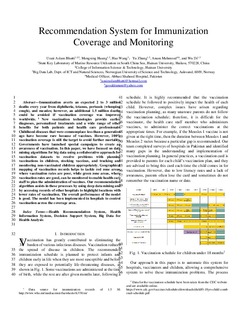Recommendation System for Immunization Coverage and Monitoring
Journal article, Peer reviewed
Submitted version
Permanent lenke
http://hdl.handle.net/11250/2462730Utgivelsesdato
2017Metadata
Vis full innførselSamlinger
- Institutt for IKT og realfag [562]
- Publikasjoner fra CRIStin - NTNU [37637]
Originalversjon
10.1080/21645515.2017.1379639Sammendrag
Immunization averts an expected 2 to 3 million deaths every year from diphtheria, tetanus, pertussis (whooping cough), and measles; however, an additional 1.5 million deaths could be avoided if vaccination coverage was improved worldwide.11 Data source for immunization records of 1.5 M: http://www.who.int/mediacentre/factsheets/fs378/en/
View all notes
New vaccination technologies provide earlier diagnoses, personalized treatments and a wide range of other benefits for both patients and health care professionals. Childhood diseases that were commonplace less than a generation ago have become rare because of vaccines. However, 100% vaccination coverage is still the target to avoid further mortality. Governments have launched special campaigns to create an awareness of vaccination. In this paper, we have focused on data mining algorithms for big data using a collaborative approach for vaccination datasets to resolve problems with planning vaccinations in children, stocking vaccines, and tracking and monitoring non-vaccinated children appropriately. Geographical mapping of vaccination records helps to tackle red zone areas, where vaccination rates are poor, while green zone areas, where vaccination rates are good, can be monitored to enable health care staff to plan the administration of vaccines. Our recommendation algorithm assists in these processes by using deep data mining and by accessing records of other hospitals to highlight locations with lower rates of vaccination. The overall performance of the model is good. The model has been implemented in hospitals to control vaccination across the coverage area.
